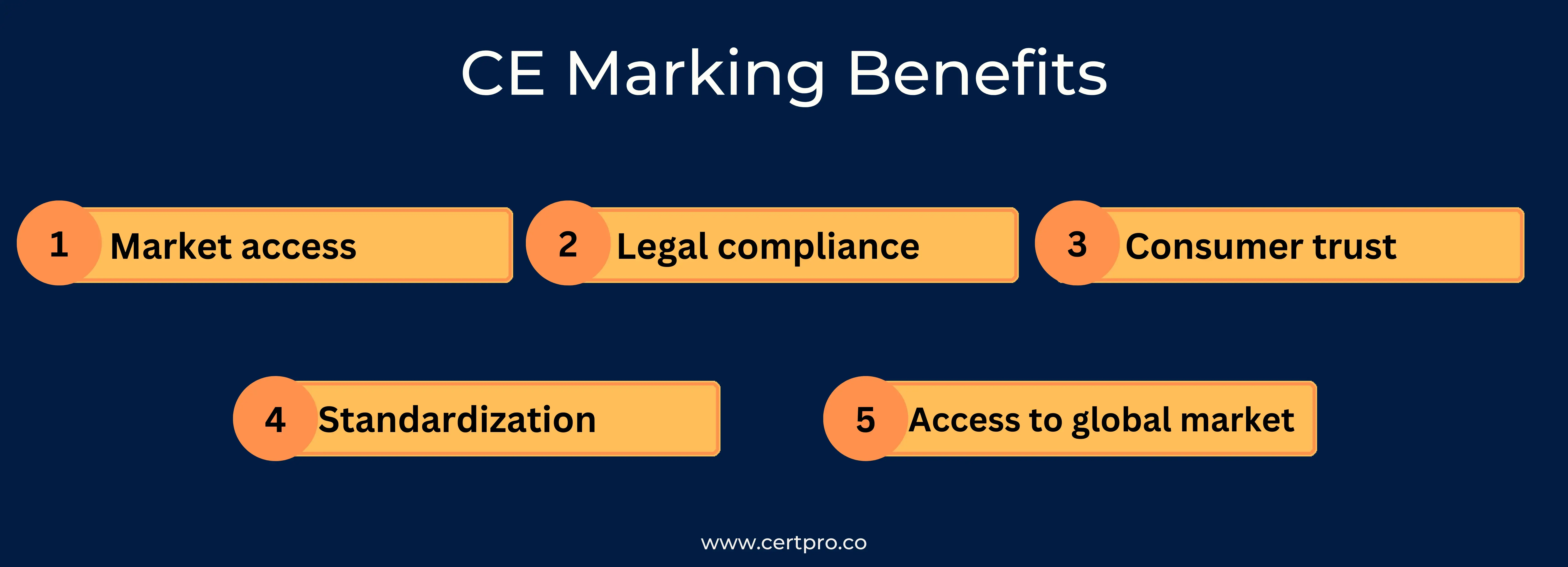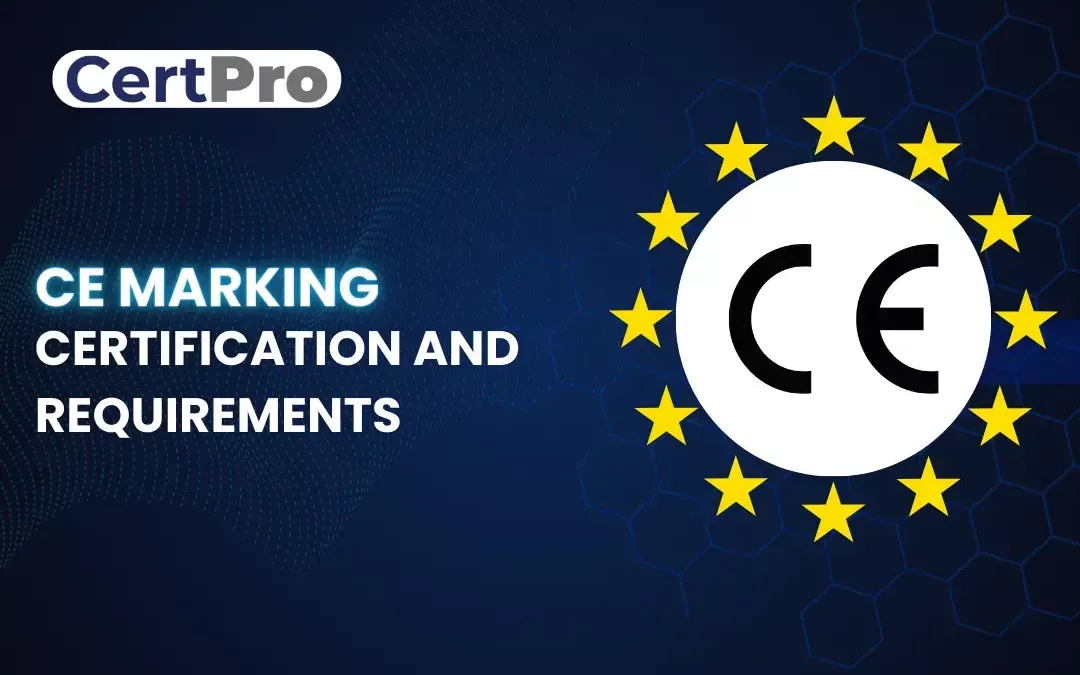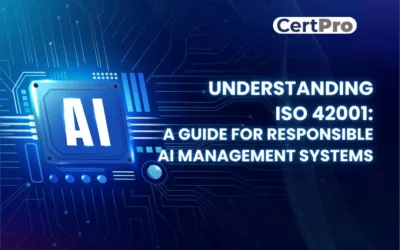These days, businesses are increasingly looking to expand their reach beyond state and national borders to vastly expand their potential in global markets. But there is a catch. Entering new markets requires compliance with a myriad of regulatory requirements. Likewise, one of the most important and essential compliances to expand your business in the European market is CE marking.
The CE Mark is a symbol of hope that signifies that the product’s are safe and in compliance with the essential health, safety, and environmental requirements set by European Union (EU) legislation. It works as a passport for the manufacturers and helps in indicating that the products of the company are meeting the stringent quality standards that are necessary for sale and distribution purposes within the European Economic Area (EEA).
In this article, we aim to provide a comprehensive introduction to CE marking certification as well as a few key functions, like the process involved and the benefits it offers manufacturing companies seeking access to the European market. Whether you are a seasoned exporter or a new entrant to international business opportunities, understanding the fundamentals of CE marking certification is an essential process for navigating the landscape of regulatory compliance.
PURPOSE OF CE MARKING
We all know that CE marking is a certification mark that indicates the product’s compliance with essential requirements set by the EU. Let’s dive deep into this topic and get to know its purpose and importance.
The purpose of CE marking is multifaceted and serves several purposes:
1. Product safety: The CE mark, which attests that products sold inside the European Economic Area (EEA) abide by all relevant environmental, health, and safety standards, ensures the safety of products. Claims that items have been evaluated and adhere to performance and safety requirements safeguard consumers.
2. Facilitating the free circulation of products: The EEA’s CE marking encourages the free circulation of products. It promotes a united market by harmonizing standards and removing technical obstacles, making it easier to sell goods between EU member states and EFTA nations.
3. Simplifying Compliance Procedures: The CE mark offers a standardized method for evaluating compliance. By providing a clear set of guidelines to follow, eliminating the need for separate assessments for each member state, and promoting market access, it streamlines the procedure for producers.
4. Promoting Fair Competition: The CE marking guarantees that enterprises operating inside the EEA have an equal playing field. It inhibits the sale of non-compliant or inferior items that may gain an unfair advantage over complying ones by ensuring compliance with common standards.
5. Supporting Product Liability: In the EEA, laws governing product liability take into account CE marking. The CE mark helps create a presumption of compliance, giving producers protection in the event of product-related legal disputes.
PRODUCTS WHICH REQUIRE CE MARKING
The CE mark is required for a wider range of products that are being manufactured or sold within the European Economic Area (EEA). The specific products that require CE Marking are determined by the regulations and directives of the EU. Here are some examples of the products that needed to have a CE mark on them.
- Machinery: Machines used in industries and factories, construction machinery, machine tools, etc.
- Electric and Electronic equipment: Household appliances, medical devices, electronic toys.
- Construction materials: materials for construction include structural steel, windows, doors, materials for thermal insulation, construction chemicals, etc.
- Medical devices: which include dental equipment, surgical instruments, diagnostic tools, implants for the body, and other items.
- Toys: include games, board toys, electronic toys, and playground equipment for kids.
- Pressure equipment: which includes boilers, pipelines, valves, pressure regulators, and pressure vessels.
- Lifts and Elevators: Escalators, moving walkways, passenger lifts, freight lifts, etc.
- Telecommunications: Mobile phones, radio gear, wireless gadgets, satellite communication gear, etc. are examples of radio and telecommunication terminal equipment.
- Explosive atmospheric equipment: Equipment for potentially explosive settings, such as those found in chemical plants or mines, is known as explosive atmosphere equipment.
THE CE MARKING PROCESS
Step 1: Determine which CE marking directives apply
EU regulations specify the basic requirements that a product must meet in order to be admitted to the single market of the European Union. It can be difficult to understand the subtleties of each directive related to the CE marking process, particularly for those who are unfamiliar with it. All of the directives are legally binding documents.
As the majority of non-food products are subject to one or more CE marking directives, manufacturers need to adeptly navigate the CE marking procedure. Sometimes a product has to comply with more than one directive; in such cases, the maker must follow all relevant requirements of all applicable directives in order to receive CE marking certification.
When starting the CE marking process, producers need to consider a number of other requirements that are unrelated to the CE marking process. These directives, which include GDPS, WEEE, REACH, and the BATTERY Directive, frequently address sustainability and environmental issues.
Step 2: Choose relevant standards
Manufacturers seeking entry into the EU single market must adhere to the CE marking directives and related standards. Essential requirements for compliance with CE marking guidelines are given forth, and it might be difficult for novices to read legal paperwork. Product categories other than food usually fall under one or more directives, and occasionally more than one. CE marking approval requires compliance with all applicable regulations. The BATTERY Directive, GDPS, WEEE, REACH, and other environmental directives are only a few of the non-CE marking requirements that manufacturers must take into account. It is essential to identify relevant standards since they outline the technical specifications needed to ensure that products meet CE marking rules regarding safety. Though not required, standardized standards make compliance easier and give producers a simpler route to compliance. They are certified for important requirements.
Step 3: Evaluation of the Notified Body
Within the EU, a Notified Body is an entity tasked with assessing a product’s compliance with CE standards. These organizations carry out conformity assessment-related duties such as examining test reports, technical data, and production facility inspections. Depending on the particular EU directive governing the goods, a Notified Body assessment may be necessary in order to receive CE marking clearance. Since not all items require Notified Body examination, it is imperative that importers or manufacturers comprehend the directives that apply to their products.
In order to guarantee a seamless evaluation, it is advised to start the application procedure as soon as possible and speak with a CE marking specialist if a Notified Body assessment is required. This proactive strategy saves a significant amount of time and streamlines future activities.
Step 4: Evaluate the conformity of the product
After defining all the standards, it is critical to collect proof that the product complies with the directive’s primary needs. In order to ensure conformity with the relevant harmonized standard(s) defined in the earlier stages of the process, this usually involves assessment and/or testing procedures. A number of criteria, including performance, safety, and technical standards, may be considered in the evaluation. This proof is essential to show that the product complies with the requirements and standards specified in the directives, confirming its eligibility for compliance and, in the end, securing the approval of the CE marking.
Step 5: Compiling technical data
Manufacturers are required to produce a technical file as part of the CE marking procedure in order to verify that a product complies with the applicable CE directive or directives. This paperwork, sometimes referred to as a technical file, verifies compliance with crucial safety regulations by providing details regarding design, production, and usage. Important elements found in the technical documentation:
- General product description
- Design details (circuit diagrams, mechanical drawings)
- Installation instructions and user manual
- List of standards used for compliance verification
- Additional documents (calculations, simulations)
- Test reports
- Copy of the EU Declaration of Conformity
Manufacturers must store the technical file in the EU for a specified duration (typically 10 or 5 years as per the relevant CE directive(s)), ensuring it is readily available for inspection by national market authorities upon request. Incomplete documentation requires correction within a 14-day period.
Step 6: Creating a Conformity Declaration
Following the completion of the technical documentation, the manufacturer is required to legally declare that the product satisfies the safety standards specified in the applicable CE marking directives. A formal document called a Declaration of Conformity is created and signed in order to make this claim.
Important details about the Conformity Declaration:
- Issuer Information: The name and address of the importer or manufacturer issuing the declaration are included in the issuer information.
- Product Identification: Provides information about the product, including its name, model or type number, and any applicable serial number.
- Citation of Directives: The relevant CE directives are defined and cited clearly.
- Verification Methods: Describes the harmonized standards or alternative techniques used to precisely and thoroughly confirm compliance with directive requirements.
- Date of Issue: This field provides the date on which the declaration was released.
- Signatory Information: Usually the CEO or product owner, this information consists of the signatory’s name, signature, and job title.
- Responsibility Statement: The product’s compliance is solely the responsibility of the manufacturer or an EU-approved representative, according to the responsibility statement.
The manufacturer or importer is in charge of ensuring CE compliance when production takes place overseas, and they have the authority to draft and sign the Declaration of Conformity. A vital component confirming a product’s compliance with regulations is this document.
DOCUMENTATION OF CE MARKING COMPLIANCE
It is essential to show conformity with regulations in case an enforcement agency challenges your product’s adherence to instructions. Make sure that your items have undergone the required testing or certification for the CE mark, and save backup documentation. Remember that different parts of a product might need to adhere to different rules and specifications.
If a product needs to be certified with the CE mark, create a special technical file with the following information:
- General product description
- Operational instructions
- Design and manufacturing drawings, including part and subassembly schemes
- Entities like the British Standards Institution specify the list of applicable harmonized standards.
- Description of methods employed to meet essential requirements for each product
- Relevant directives applicable to the product
- Results of design calculations
- Test reports, whether from suppliers or commissioned through an independent testing body
Technical files must be kept for ten years following the end of manufacturing, according to regulations. At any time, organizations from the UK or other EU member states in charge of keeping an eye on product conformity may audit these files. These files are also useful for showing prospective clients that you are in accordance with the law.
THE BENEFITS AND ADVANTAGES OF OBTAINING CE MARKING
For producers looking to sell their goods in Europe, obtaining a CE mark for their goods has many advantages. Here are a few significant benefits:
1. Market Access: The European Economic Area (EEA) requires that many items sold there have the CE mark. Manufacturers may reach a market of more than 500 million customers in the EU member states and EFTA countries by getting the CE marking. It permits the unrestricted flow of commodities without the need for extra technological hurdles, allowing producers to grow their consumer base and market potential.
2. Legal Compliance: The CE marking shows that a product complies with the crucial health, safety, and environmental standards established by EU law. Manufacturers can operate legally by adhering to these regulations, which reduces their exposure to fines, product recalls, and legal issues. Additionally, it enables producers to satisfy their regulatory duties with attention.
3. Consumer Trust: The CE marking certification increases consumer trust in the reliability and safety of a product. The CE mark is a sign of conformance to EU standards and regulations that consumers recognize. By displaying the CE mark, manufacturers show that their goods have undergone thorough evaluation and comply with all regulations, promoting customer trust and enabling well-informed purchase decisions.
4. Standardization: The CE marking encourages standardization across EFTA nations and EU member states. It guarantees that goods from many producers and nations comply with a common set of standards, leveling the playing field for enterprises. Harmonization promotes fair competition and supports economic growth by streamlining the trading process, lowering entry barriers, and facilitating the flow of commodities inside the EU.
5. Access to the global market: Although CE marking is unique to the European market, it may also act as a helpful stepping stone for entering other markets. The CE certification is accepted as proof of adherence to globally recognized safety standards in many nations outside of the EU. Manufacturers with CE marking may find it simpler to reach international markets or to go through the certification procedures necessary for such markets.
On a serious note, It’s crucial to understand that the CE mark is not a sign of product quality, effectiveness, or fit for a certain application. However, it is a recognized mark that denotes adherence to EU standards, giving firms a distinct edge when entering and conducting business in the European market.

COMMON CHALLENGES AND PITFALLS IN THE PROCESS
Manufacturers seeking compliance face a number of obstacles and traps throughout the CE marking procedure. It can be difficult to comprehend the relevant instructions and standards; therefore, it requires cautious interpretation to prevent errors.
To guarantee compliance, the proper conformity assessment approach must be chosen, whether it involves self-evaluation or a designated authority. It is also crucial to produce thorough technical documentation that correctly illustrates compliance with regulations.
The management of testing and certification processes must take into account the participation of recognized laboratories and the synchronization of certificates from notified organizations. It’s crucial to keep up with changing laws and standards since failing to do so might lead to non-compliance. Multinational compliance adds a further degree of complexity and calls for knowledge of regional differences. Constraints on time and money, as well as maintaining documentation, make the issues encountered during the CE marking certification process even worse.
Manufacturers should seek professional advice, interact with notified agencies, and keep up with regulatory developments in order to effectively manage these difficulties. The keys to success are careful planning, close attention to detail, and proactive compliance management. Manufacturers can assure a seamless and error-free CE marking procedure, reducing risks and improving entry to the European market, by tackling these hazards up front.
GET EXPERT HELP IN YOUR CE MARKING JOURNEY
For manufacturers, starting the CE marking process might be a difficult endeavor. That’s where CertPro, your dependable partner, steps in. We provide extensive support to help you manage the intricacies and guarantee a successful conclusion thanks to our expertise and in-depth understanding of the CE marking procedure. Get in touch for further details
FAQ
Can products without CE marking be sold in the EU?
Generally, products requiring CE marking cannot be legally sold in the EU without obtaining the certification. However, there might be exceptions for certain products or specific circumstances.
Can a product be CE marked without testing?
In most cases, testing is required to demonstrate conformity with applicable EU directives. However, certain product categories may allow for self-declaration without mandatory testing.
How long does CE marking certification remain valid?
CE marking certification does not have an expiration date. However, it is the manufacturer’s responsibility to ensure ongoing compliance and update the certification if changes are made to the product.
Is CE marking certification applicable to services or only physical products?
CE marking certification primarily applies to physical products. Services generally do not require CE marking but may be subject to other regulations or certifications.
What are the main requirements for obtaining CE marking certification?
The main requirements include ensuring conformity with applicable EU directives, conducting risk assessments, performing testing and documentation, and implementing a quality management system.

About the Author
BENEDICT ESSANDOH
Benedict Essandoh, CertPro’s Regional Director in Ghana, is a compliance and ISO standards expert. Specializing in health and safety, he conducts audits, implements ISO 9001 and ISO 45001, and excels in accident investigation and site inspections, ensuring international standards are met.
HOW DOES THE NIST CYBERSECURITY FRAMEWORK FUNCTION, AND WHY IS IT IMPORTANT?
Emerging cyber threats make cybersecurity an essential consideration for organizations handling and managing data. In this regard, the NIST cybersecurity framework applies to improving your cybersecurity program. It is a set of guidelines that helps improve your...
UNDERSTANDING ISO 42001: A GUIDE FOR RESPONSIBLE AI MANAGEMENT SYSTEMS
The invention of artificial intelligence (AI) has changed the operational processes of many industries. However, the rapid growth of technology increases ethical, security, and privacy-related concerns. Therefore, the International Organization for Standardization...
EUROPEAN UNION’S ARTIFICIAL INTELLIGENCE ACT: HOW THIS GROUNDBREAKING LAW AFFECTS YOUR BUSINESS
Nowadays, Artificial Intelligence (AI) is transforming our lives exceptionally well. AI is now streamlining healthcare services, providing virtual assistance, and fulfilling queries. Technologies have boons and curses. Similarly, AI creates many concerns about...




